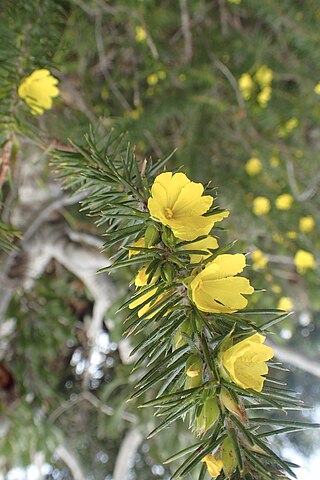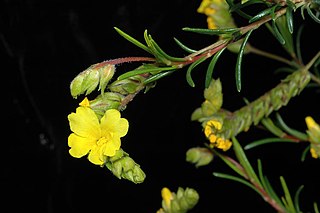Hibbertia acrotrichion is a species of flowering plant in the family Dilleniaceae and is endemic to a restricted area of Western Australia. It is a small, erect shrub with linear, cylindrical leaves and yellow flowers arranged singly in leaf axils with eleven stamens arranged in groups.
Hibbertia ancistrophylla is a species of flowering plant in the family Dilleniaceae and is endemic to the south-west of Western Australia. It is a shrub with sessile, linear leaves and bright yellow flowers arranged singly in leaf axils with eight to eleven stamens fused at their bases on one side of the carpels.
Hibbertia axillibarba is a species of flowering plant in the family Dilleniaceae and is endemic to a restricted area of the south-west of Western Australia. It is a shrub with crowded narrow oblong to linear leaves. Its yellow flowers are arranged singly on short side shoots with ten or eleven stamens fused at their bases on one side of the two densely hairy carpels.
Hibbertia carinata is a species of flowering plant in the family Dilleniaceae and is endemic to the south-west of Western Australia. It is a shrub with crowded linear leaves and yellow flowers with nine to eleven stamens fused at their bases on one side of the two densely hairy carpels.

Hibbertia ferruginea is a species of flowering plant in the family Dilleniaceae and is endemic to the south-west of Western Australia. It is an erect or spreading shrub with linear, sessile leaves and yellow flowers borne in leaf axils near the ends of branchlets with fifteen stamens in five groups surrounding the five carpels.
Hibbertia glabrisepala is a species of flowering plant in the family Dilleniaceae and is endemic to the south-west of Western Australia. It is an erect to sprawling shrub with linear to narrow oblong leaves and bright yellow flowers borne on the ends of short side shoots, with fifteen stamens in groups surrounding the five carpels.

Hibbertia glomerosa is a species of flowering plant in the family Dilleniaceae and is endemic to the south-west of Western Australia. It is a shrub with linear to narrow oblong leaves and bright yellow flowers borne on the ends of short side shoots, with twenty-five to thirty-eight stamens arranged in groups of five around the five glabrous carpels.

Hibbertia hamulosa is a species of flowering plant in the family Dilleniaceae and is endemic to the south coast of Western Australia. It is a shrub with somewhat crowded, thick, linear leaves and golden yellow flowers with five to eight stamens fused at their bases, all on one side of two densely hairy carpels.

Hibbertia hibbertioides is a species of flowering plant in the family Dilleniaceae and is endemic to near-coastal areas of south-western Western Australia. It is a small, prostrate or sprawling shrub with crowded, linear cylindrical leaves and yellow flowers with usually eleven stamens arranged in groups around three carpels.
Hibbertia hooglandii is a species of flowering plant in the family Dilleniaceae and is endemic to the Kimberley region of Western Australia. It is a small, erect or spreading, multi-stemmed shrub with linear leaves and golden yellow flowers arranged singly in leaf axils, with seventeen to twenty-five stamens, all on one side of two densely hairy carpels.
Hibbertia lividula is a species of flowering plant in the family Dilleniaceae and is endemic to the south-west of Western Australia. It is an erect or sprawling shrub with thin branchlets, bluish-grey, narrow elliptic to narrow oblong leaves and yellow flowers, with thirty to forty stamens arranged around the five glabrous carpels.
Hibbertia notibractea is a species of flowering plant in the family Dilleniaceae and is endemic to the south-west of Western Australia. It is an erect, sprawling or prostrate shrub with linear to narrow elliptic leaves and yellow flowers with eleven stamens, nine in groups of three, arranged around three glabrous carpels.

Hibbertia porongurupensis is a species of flowering plant in the family Dilleniaceae and is endemic to a restricted area of the south-west of Western Australia. It is a glabrous shrub with broadly elliptic to more or less round leaves and yellow flowers arranged singly in leaf axils with large numbers of stamens arranged around five carpels.
Hibbertia priceana is a species of flowering plant in the family Dilleniaceae and is endemic to the south-west of Western Australia. It is a dwarf, usually compact shrub with erect, narrow elliptic leaves and bright yellow flowers with eleven stamens, nine in three groups of three, around three glabrous carpels.
Hibbertia psilocarpa is a species of flowering plant in the family Dilleniaceae and is endemic to the south-west of Western Australia. It is a shrub with spirally arranged, narrow oblong to linear leaves and yellow flowers usually with four to eight stamens, all on one side two glabrous carpels.

Hibbertia rupicola is a species of flowering plant in the family Dilleniaceae and is endemic to the south-west of Western Australia. It is a shrub with densely-clustered, linear leaves and yellow flowers with nine to seventeen stamens arranged around three glabrous carpels.

Hibbertia spicata is a species of flowering plant in the family Dilleniaceae and is endemic to the west of Western Australia. It is a low, erect to spreading shrub with scattered linear leaves with the edges rolled under and yellow flowers with six or seven stamens on one side of two softly-hairy carpels, and a larger number of staminodes.
Hibbertia stenophylla is a species of flowering plant in the family Dilleniaceae and is endemic to Western Australia. It is a shrub with thick, linear to cylindrical leaves and yellow flowers with ten stamens in a single group on one side of two densely hairy carpels.
Hibbertia trichocalyx is a species of flowering plant in the family Dilleniaceae and is endemic to the south coast of Western Australia. It is an erect, spreading shrub with oblong to elliptic leaves and yellow flowers with eleven stamens arranged around three glabrous carpels.
Hibbertia turleyana is a species of flowering plant in the family Dilleniaceae and is endemic to a small area in the south of Western Australia. It is a low-lying shrub with more or less glabrous, linear leaves and bright yellow flowers with eight or nine stamens in a single group on one side of two densely hairy carpels.







